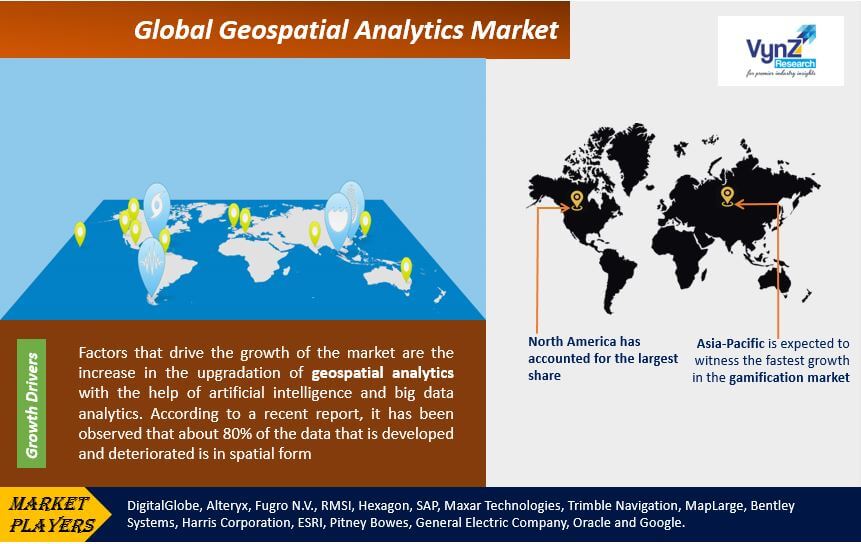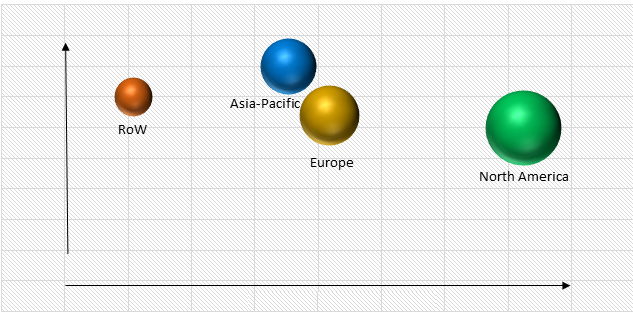| Status : Published | Published On : Jun, 2025 | Report Code : VRICT5002 | Industry : ICT & Media | Available Format :

|
Page : 188 |
Global Geospatial Analytics Market – Analysis and Forecast (2026 – 2035)
Industry Insights by Component (Services and Software & Solutions), by Type (Network & Location Analytics, Surface & Field Analytics, Geovisualization and Others), by Application (Medicine & Public Safety, Climate Change Adaptation, Surveying, Disaster Risk Reduction & Management and Others), by Vertical (Automotive, Defense & Intelligence, Utility & Communication, Business, Natural Resources, Government and Others) and by Geography (North America, Europe, Asia-Pacific, Middle East, and Rest of the World)
Industry Overview
The global geospatial analytics market is anticipated to grow at a CAGR of 13.8%, along with market valuation from USD 51.6 billion in 2025 to USD 97.3 billion in 2035. Technological advancement and the emergence of the latest technologies, such as IoT (Internet of Things), big data, and artificial intelligence, as well as the exaggerated demand for the system by various companies in developed and developing economies, have driven the growth of the market. These developments have also enabled the integration of information systems with hybrid cloud computing environments.

Geospatial analytics helps to display, collect and manage imagery, satellite photos, GPS, and the collection of historical data that are recorded in geographic areas based on zip codes and street addresses. Geospatial analytics is used in various industries, including government and defense, utilities, public safety, healthcare, and natural resources. Overall, the combination of increasing geospatial data availability, technological advancements, demand for location-based services, government support, and industry adoption is driving the growth of the geospatial analytics market.
Geospatial Analytics Market Segmentation
Insight by Component
- Services
- Software
- Solutions
The services category is anticipated to have faster growth during the forecast period, as this segment is attributable to the growing demand for deployment, training, and support services by companies, governments, and public safety agencies after the installation of geospatial systems.
Insight by Type
- Network
- Location Analytics
- Surface
- Field Analytics
- Geo-Visualization
- Others
The network and location analytics segment is anticipated to experience the fastest growth during the forecast period as it is helping companies of several domains to analyze the buying behavior and foot-traffic patterns to expand their market base and effectively determine the target audience for their products.
Insight by Application
- Medicine & Public Safety
- Climate Change Adaptation
- Surveying
- Disaster Risk Reduction & Management
- Others
Due to the latest technological developments, such as sensors that can access large amounts of geospatial data, surveying applications will account for the largest share during the forecast period.
Insight by Vertical
- Automotive
- Defense & Intelligence
- Utility & Communication
- Business
- Natural Resources
- Government
- Others)
Above all, the automotive sector is anticipated to experience the fastest growth during the forecast period. The growth of this category is attributed to the extensive use of new and advanced technologies such as IoT, 5G, and self-driving cars. The major concern among the population is safety. As a result, the government has authorized the implementation of GPS and GIS techniques in vehicles, thereby bolstering the growth of the global geospatial analytics market.
Global Geospatial Analytics Market Report Coverage
|
Report Metric |
Details |
|
Historical Period |
2020 - 2024 |
|
Base Year Considered |
2025 |
|
Forecast Period |
2026 - 2035 |
|
Market Size in 2025 |
U.S.D. 51.6 Billion |
|
Revenue Forecast in 2035 |
U.S.D. 97.3 Billion |
|
Growth Rate |
13.8% |
|
Segments Covered in the Report |
By Component, By Type, By Application, and By Vertical |
|
Report Scope |
Market Trends, Drivers, and Restraints; Revenue Estimation and Forecast; Segmentation Analysis; Impact of COVID-19; Companies’ Strategic Developments; Market Share Analysis of Key Players; Company Profiling |
|
Regions Covered in the Report |
North America, Europe, Asia-Pacific, Middle East, and Rest of the World |
Industry Dynamics
Trends
The rapid increase in the adoption of the latest technology and the growing demand for location-based services are the main trends observed in the global geospatial analytics market. Technologies such as commercial and spatial analysis, location services, Internet of Things, AR, and VR are very few technologies that emphasize the demand for geospatial analysis systems. For example, AR and VR technologies plays an important role in the manufacturing industries for construction and help users to identify the real space available in the real world converted from the virtual world. These technologies play an important role when natural disasters occur and help protect and ensure the safety of people during rescue operations.
Additionally, government initiatives and regulations promoting the use of geospatial data are propelling market growth. Many governments recognize the value of geospatial information for urban planning, disaster management, infrastructure development, and national security. They are investing in geospatial technologies and encouraging public-private partnerships to leverage geospatial analytics for socioeconomic development.
Geospatial Analytics Market Growth Drivers
Factors that drive the growth of the market are the increase in the upgradation of geospatial analytics with the help of artificial intelligence and big data analytics. According to a recent report, it has been observed that about 80% of the data that is developed and deteriorated is in spatial form, and artificial intelligence and automation technologies are adopted to make the data available for various other industries.
One of the key growth drivers for the geospatial analytics market is the increasing availability of geospatial data. With the proliferation of sensors, satellites, and connected devices, there is a massive volume of geospatial data being generated every day. This data provides valuable insights into various industries such as transportation, urban planning, agriculture, defense, and environmental monitoring.
Another growth driver is the advancements in technology, particularly in the fields of artificial intelligence (AI), machine learning (ML), and big data analytics. These technologies enable more efficient and accurate analysis of geospatial data, leading to improved decision-making and operational efficiency for businesses and organizations.
In addition, the increasing deployments of IoT is another factor driving the growth of the global geospatial analytics market. There are various sensors, such as scanners and cameras, that provide data to smart systems on a daily basis, including data related to transportation, healthcare, energy, and agriculture. Various industries are using this data to predict machine failures and automatically eliminate them before they become obsolete. In addition, the increasing popularity and advantages of these latest technologies are helping business enterprises to effectively carry out business operations, thereby propelling the growth of the global geospatial analytics market.
Geospatial Analytics Market Restraints
The factors hampering the growth of the geospatial analytics market are the high setup costs, high acquisition costs, and operational concerns such as lack of skilled human resources. In addition, the high level of complexity involved in the system and the limited knowledge and use of geospatial systems by small and medium-sized companies hamper the growth of the global market.
Geospatial Analytics Market Industry Ecosystem
Globally, industry participants are taking advantage of market growth through new product development, mergers and acquisitions, partnerships, increased investment, and technology development, which are driving the growth of the global geospatial analytics market.
Geospatial Analytics Market Geographic Overview
North America dominates the geospatial analytics market during the forecast period, owing to technological developments and the increasing adoption of emerging technologies such as big data, cloud computing, artificial intelligence, the Internet of Things (IoT), business intelligence tools, and artificial intelligence (AI). In addition, extensive security measures in several border areas are expected to promote the growth of the North American geospatial analysis market.
Global Geospatial Analytics Market, By Region

Asia-Pacific is anticipated to have the highest growth in the geospatial analytics market due to rapid urbanisation in countries such as India, China, and Indonesia. Thus there is a high demand for smart cities, smart infrastructure, and well-planned urban landscapes.
Key Players Covered in the Report
Some of the key players operating in the global geospatial analytics market are DigitalGlobe, Alteryx, Fugro N.V., RMSI, Hexagon, SAP, Maxar Technologies, Trimble Navigation, MapLarge, Bentley Systems, Harris Corporation, ESRI, Pitney Bowes, General Electric Company, Oracle, and Google.
Recent developments by Key Players
As a new component of Alteryx’s Analytics Cloud Platform, generative AI is added to Analytics Suite AiDIN. This component leverages generative AI capabilities in the following three ways such as an automated workflow documentation function called Workflow Summary, an automated analytics summary function called Magic Documents, and the capability to tap into OpenAI APIs directly. As the company's first generative AI offering (dubbed AiDIN) is been available for cloud customers from now onwards.
Maxar Technologies has released the company’s Maxar Geospatial Platform (MGP) through which, World’s most advanced Earth intelligence can be accessed in an easy way. Discovery, integration, and use of geospatial data and analytics shall be simplified. MGP users can access Maxar’s industry-leading geospatial content that includes 3D models, analysis-ready data, high-resolution satellite imagery, stunning imagery basemaps, and image-based change detection and analytic outputs.
.png)
Source: VynZ Research
Frequently Asked Questions
Purchase Options
Latest Report
Research Methodology
- Desk Research / Pilot Interviews
- Build Market Size Model
- Research and Analysis
- Final Deliverabvle
Connect With Our Sales Team
- Toll-Free: 1 888 253 3960
- Phone: +91 9960 288 381
- Email: enquiry@vynzresearch.com
Geospatial Analytics Market
